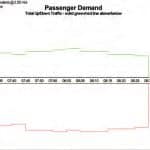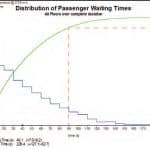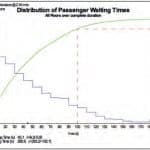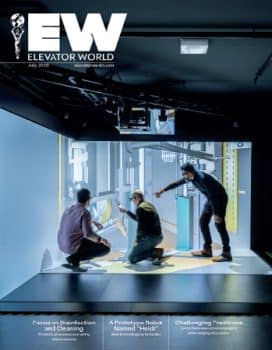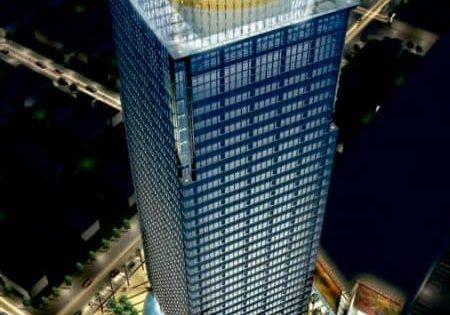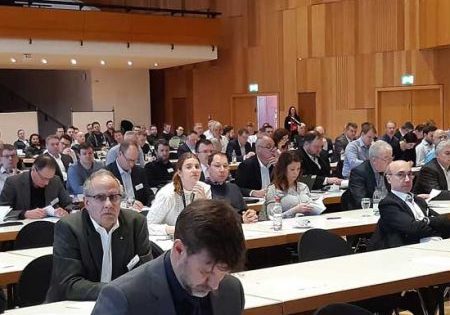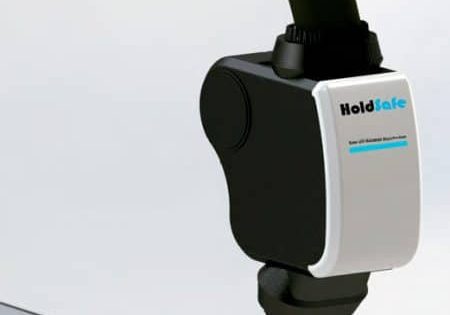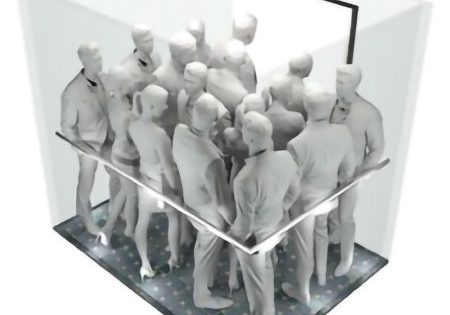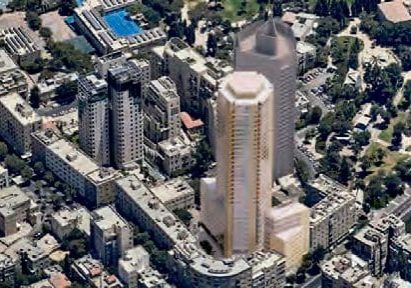Your author takes an in-depth look at the special demands different types of robots place on lifts.
by Dr. Rory Smith
This article was first presented at the 10th
Symposium on Lift & Escalator Technologies, www.liftsymposium.org.
Lifts are increasingly being called upon to transport robots between floors in multistory buildings. The robots that are presently available place special demands on lifts, and those demands affect traffic handling. Here, the special demands are explained and the impact of those demands on waiting time and transit time are reviewed using simulation.
Introduction
Robot Types
There are two principal types of robots: Industrial robots and service robots. Industrial robots are used for manufacturing.[1] A service robot is defined by the International Organization for Standardization (ISO) as a robot “that performs useful tasks for humans or equipment, excluding industrial automation applications.”[2] Service robots are further subdivided into three categories by the International Federation of Robotics:[3]
- Professional service robots
- Service robots for domestic/household tasks
- Service robots for entertainment
Service robots for domestic/household tasks are such things
as robotic carpet cleaners. Service robots for entertainment are, essentially, toys. Therefore, this article addresses only professional service robots.
While there are many types of professional service robots, including some that milk cows and others that have military applications, there is a subset of professional service robots that will ride in lifts with humans. ISO 13482 further defines these types of robots as “Mobile Servant Robots.”[4] Mobile servant robots are classified as either Type 1.1 or Type 1.2, based on the following characteristics:
- Type 1.1: small and lightweight and slow and no manipulator
- Type 1.2: large or not lightweight or fast or with manipulator
Building Types Where Robots Use Lifts
There are four building types in which mobile servant robots are being applied in increasing numbers. These building types are hotels, office buildings, residential buildings and hospitals:
- In hotels, servant robots are being used for room-service deliveries and for the delivery and movement of housekeeping carts.
- In office buildings, robots are delivering packages and mail from sources outside the building, as well as interoffice correspondence.
- The growth of e-commerce has caused an increase in package deliveries to multistory residential buildings. Robots are being used to make the final delivery from the lobby to the residential unit.
- Hospitals have used pneumatic tube systems for delivery of medicines and transportation of medical records. Pneumatic tube manufacturers are now offering robots as an alternative to tubes.[5]
General Safety Standards for Robots
ISO 13482 establishes safety requirements for personal care robots.[4] This standard identifies 53 hazards that need to be addressed through risk assessment. The standard establishes performance levels (PLs) for safety-related control functions. PLs are defined in ISO 13849-1:2015 Safety of Machinery—Safety-related parts of control systems.[6]
Both Type 1.1 and Type 1.2 mobile servant robots are required to achieve PL “D” for their emergency stop function. For all other safety functions, Type 1.1 robots must achieve PL “B”, while Type 1.2 robots must achieve PL “D.”
PL B indicates that the probability of a dangerous failure is between 1 X 105 and 3 X 106. PL D indicates that the probability of a dangerous failure is between 1 X 106 and 1 X 107.
Robot Characteristics That Affect Lifts
Mass and Size
There are two basic types of mobile servant robots manufactured by several manufacturers that need to use lifts to be effective. One type is a high-mass vehicle referred to as a “tug” by one manufacturer.[7] The other type of robot is a low-mass unit used for room service.
The tug type of robot has a payload of 453 kg. The tug and its lead-acid batteries also have significant mass. It is 1,164 mm long and 570 mm wide. It has a turning envelope of 1,270 mm.[7] This is a Type 1.2 robot.
The room-service robot has a total mass, including payload, of 50 kg. This robot is cylindrical, and its diameter is 500 mm. The turning envelope is also 500 mm.[8] This is a Type 1.1 robot.
The room-service robot is designed to ride in the lift with human passengers. The mass, size and turning envelope of the tug type robot needs a much larger lift. Consideration should be given to limiting the access of a tug type robot to service lifts.
Velocity
Both types of robots have velocities of 0.76 m/s. Humans walking to a lift can be assumed to have a walking speed of 1.0 m/s.[9] Walking speed is a component of loading time.
Kinetic Energy
Kinetic energy is defined by the following equation:[10]
KE = 1/2 mv2 (1)
where KE represents kinetic energy, m represents mass, and v represents velocity.
The ASME A17.1 code has kinetic energy and velocity limits for dumbwaiters with automatic transfer devices.[11]
An automatic transfer device is defined as “a power-operated mechanism that automatically moves a load consisting of a cart, tote box, pallet, wheeled vehicle, box or other similar object from and/or to the car.” The kinetic energy limit is 40 J, and the velocity limit is 0.5 m/s during unloading. These limitations do not apply directly to robots riding with human passengers, as passengers do not ride in dumbwaiters. However, they provide some guidance in the lack of a robot-specific standard.
In the case of a tug type robot with a total mass of 600 kg (453 kg payload and 147 kg estimated tug mass), the loading speed would need to be reduced 0.365 m/s during loading and unloading to comply with the 40 J limitation. A room-service robot operating at 0.76 m/s does not exceed the 40 J limit. However, it does exceed the 0.5 m/s velocity maximum. Therefore, the maximum velocity during loading and unloading should be limited to 0.5 m/s.
Based on kinetic energy and velocity limits, the loading and unloading times for robots should be greater than the loading and unloading time for humans. Data needs to be gathered by observing loading operations with robots operating at these speeds. In the absence of this data, it would seem logical to add 1.2 s to both loading and unloading times when assessing the impact of robots on traffic-handling performance. These increased times will increase waiting and transit times.
Personal Space
Personal space, as it relates to lifts, defines the number of passengers that will ride in a lift at one time. CIBSE Guide D: Transportation Systems in Buildings suggests that an adult male will occupy a space of 0.21 m².[9] This is based on the male being a European or North American and does not include personal space.
Dr. Gina Barney proposes that the design capacity of a lift should be based upon approximately 0.263 m² per person.[12]Personal space is space between humans. Robots are not humans. There is some research that indicates humans do not view robots as social entities (humans).[13] The spatial distance that humans will require with robots is probably affected by the same factors that affect spatial distance between humans, such as age and culture.
Research is needed in this area. However, in the absence of data, a starting point might be to add a buffer zone of 150 mm around a room-service robot. For example, a cylindrical robot with a diameter of 500 mm would occupy 0.5 m² (space diameter of 800 mm).
Personal space for tug type robots should be different, because they will need large lifts due to their mass, physical dimensions, and turning envelopes. Tug robots will not be considered in the next section.
Traffic Effects
A study of the impact of room-service robots being installed in an existing four-star hotel in California related to passenger traffic was conducted. The following are the building, lift system and passenger characteristics used for this traffic study.
Building:
- Floors: 25
- Rooms: 510, located on levels 4–25
- Dispatch lobby: Level 1
- Occupancy: 440, based on 86% occupancy and one person per room
Lift System:
- Number of cars: 4
- Capacity: 1600 kg
- Speed: 2.5 m/s
- Dispatch algorithm: Estimated time of arrival
- Door Type: Center opening
- Door width: 1,066 mm
- Car loading: 60% by volume
Passengers, humans:
- Loading time: 1.2 s
- Unloading time: 1.2 s
- Area: .26 m²
Passengers, robots (room-service type):
- Loading time: 2.4 s
- Unloading time: 2.4 s
- Area: 0.5 m²
Figures 2 and 3 show the results of traffic simulations using a Peters Chartered Institution of Building Services Engineers (CIBSE) hotel template with no robots installed. Figure 2 shows waiting times, while Figure 3 shows transit times.
Figures 4 and 5 show the results of traffic simulations using a Peters CIBSE hotel template with one additional person making a room-service delivery. The one person makes one delivery round trip every 5 min. Figure 4 shows waiting times, while Figure 5 shows transit times.
Figures 6 and 7 show the results of traffic simulations using a Peters CIBSE hotel template with one robot making a room-service delivery. The one robot makes one delivery round trip every 5 min. Figure 6 shows waiting times, while Figure 7 shows transit times.
Table 1 summarizes these results.
It should be noted that one robot will increase waiting time by 12.5% more than one person due to “personal space” and loading/unloading time.
| Waiting Time | Transit Time | Time to Destination | |
| No robots | 36.1s | 57.0s | 93.1s |
| With 1 additional person | 40.1s | 60.9s | 101.0s |
| With 1 robot | 45.1s | 62.1s | 107.2s |
| Additional time for 1 robot compared to 1 person | 5.0s | 1.2s | 6.2s |
Conclusions
Robots should be considered a new class of passenger, because they do not yet behave in the same manner as humans. At present, their speed must be controlled during loading and unloading to either control kinetic energy or velocity. With continuing improvements in machine vision, robots may become better at avoiding collisions with people and property than humans, and these restraints could be relaxed.
The physical shape of robots is different from that of humans, so the floor space they occupy is different from humans.
More research is needed to understand the human interaction with robots as passengers. We need to know how much personal separation humans need between themselves and robots.
The speed and personal space characteristics of robots have a negative effect on the traffic-handling capacity of lift systems. If robots are planned for a new building, the proposed lift system should be designed acknowledging these effects. If robots are proposed for an existing building, a traffic study should be performed that demonstrates the impact of the robots. As robot installations increase, lift traffic consultants need to understand the impact of robots on traffic so they can properly advise their clients.
- Figure 1: A representation of passenger demand levels of hotel traffic when applied to the occupancy of the subject hotel; Peters, CIBSE
- Figure 2: Waiting times without robots
- Figure 3: Transit times without robots
- Figure 4: Waiting times with one additional human passenger
- Figure 5: Transit times with one additional human passenger
- Figure 6: Waiting times with one robot
- Figure 7: Transit times with one robot
References
[1] wikipedia.org/wiki/Industrial robot
[2] ISO 8373: 2012 Robots and Robotic Devices — Vocabulary.
[3] Executive Summary, World Robotics, 2017 Service Robots (ifr.org/downloads/press/Executive_Summary_WR_Service_
Robots_2017_1.pdf).
[4] ISO 13482: 2014 Robots and Robotic Devices – Safety Requirements for Personal Care Robots
[5] Relay Autonomous Service (swisslog.com/en-us/healthcare/products/material-transport/autonomous-service-robot). ISO 13849-1:2015 Safety of
[6] Machinery/Safety-Related Parts of Control System.
[7] TUG T3 Autonomous Mobile Robot (aethon.com/tug).
[8] “Discussions with Phil Herget,” Savioke Robotics (January 2018)
[9] CIBSE Guide D: Transportation Systems in Buildings. CIBSE, Norwich (2015).
[10] Giancoli, D. Physics: Principles with Applications. Boston, Pearson (2012).
[11] ASME A. SME A17.1: Safety Code for Elevators and Escalators
New York (2013).
[12] Barney, G. Elevator Traffic Handbook. London: Spon Press (2003).
[13] Walters, M. et al, Close Encounters: Spatial Distances Between People and a Robot of Mechanistic Appearance. In: Proceedings of 2005 5th IEEE-RAS International Conference on Humanoid
Robots (2005).
Get more of Elevator World. Sign up for our free e-newsletter.
